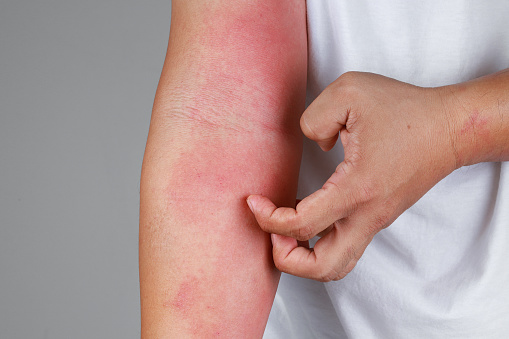The Difference Between Paget’s Disease and Eczema
If you suffer from eczema and are concerned that it’s a sign of Paget’s disease, there are several things you should know. This article discusses symptoms, diagnosis, treatment, and adjuvant therapy. If you’d like more information, you can also sign up for our free newsletter.
Symptoms
A biopsy is one of the most common ways to diagnose Paget’s disease. It takes a small piece of tissue and examines it under a microscope. The pathologist looks for Paget cells. If Paget cells are found, the patient will need further breast cancer screening.
The disease is most commonly seen in older women. It usually affects the nipple and areola surrounding it. It may initially be misdiagnosed as a skin rash or an infection and may go undetected for months or even years. The rash may also spread to other parts of the body, causing pain or discomfort.
The disease can cause a lump or rash that is red and scaled. Although the cause of Paget’s disease is not known, it is related to ductal cancer. A mammogram or clinical breast exam may be used to diagnose Paget’s disease.
Cells that cause Paget’s disease contain mucin and pleomorphic nuclei. They may be single or small clusters of cells. They should show evidence of malignancy on a cytological analysis. A high-grade pleomorphic nucleus and abundant cytoplasm should be present.
If you experience Paget’s disease on your nipple, it is important to see a doctor as it can be an indication of breast cancer. The rash can be red, itchy, and scaly, and may even bleed if left untreated. It can also become ulcerated and scab over.
Treatments for Paget’s disease include surgery and radiation therapy. This treatment can remove cancer cells and prevent it from returning. It may also involve hormone therapy. If the cancer is hormone receptor-positive, the patient is often prescribed hormone therapy to lower the levels of hormones in the body.
Diagnosis
A proper diagnosis of Paget’s disease requires careful attention to your medical history and a physical examination. In some cases, a mammogram may also be helpful. During a physical exam, the doctor may also perform a skin biopsy to check for evidence of cancer beneath the skin’s surface. This procedure is typically performed using a local anesthetic and involves removing a small piece of the skin and underlying breast tissue and sending it for examination under a microscope.
An eczematous rash near the nipple is a clinical symptom. In advanced cases, it may be associated with psoriasis or chronic dermatitis. In 80% of cases, no mass is palpable. A full-thick skin biopsy can confirm the diagnosis. The cells found in this biopsy have hyperchromatic nuclei, which indicate Paget’s disease. Radiology may also be necessary to diagnose the underlying cancer and determine clinical staging.
When a patient presents with extramammary Paget’s disease, a red scaly lesion is present. The skin condition is usually accompanied by burning, itching, and pain. The disease may involve the external genitals, including the anus.
Diagnosis of Paget’s cancer can be difficult because the skin lesion may look like another skin condition. A biopsy is a common diagnostic tool. A sample of tissue is removed for examination under a microscope. Before the biopsy, a local anaesthetic is used to numb the area. An ultrasound or mammogram may also help with diagnosis.
The symptoms of Paget’s disease are similar to those of eczema. Most cases affect one breast, but it may also affect both breasts. In some cases, the disease begins in a breast nipple and spreads to the areola.
If you’ve noticed a rash on your nipple, it may be Paget’s disease. It is usually characterized by red, scaly skin that may bleed and become ulcerated. If left untreated, it can develop into invasive breast cancer.
It is important to consult with a physician as soon as you notice symptoms. It may be just a mild case of eczema, but it can easily be mistaken for other skin conditions. If the symptoms persist, you should consult a medical professional to determine whether Paget’s disease is the source of your problem.
Treatment
While Paget’s disease is typically associated with the breast, it can also affect the bones and skin. It is rare and is most often found in females, though it can affect men as well. The disease was first described by Sir James Paget in 1874 and is often characterized by chronic inflammatory changes on the breast. If left untreated, the disease may progress to cancer of the breast.
When a woman has Paget’s disease, the skin on one nipple is scaly and red. The rash is itchy and may become ulcerated. Depending on the severity of the disease, it may also bleed or scab over.
Treatment for Paget’s disease involves careful diagnosis. A physical examination and mammogram are needed to rule out other conditions. However, as the skin changes are so similar to those of other skin conditions, a biopsy is necessary to determine if the condition is cancerous. This procedure is done using local anaesthetic and involves taking a small sample of skin and underlying breast tissue. The tissue is then sent to a laboratory for analysis under a microscope.
The symptoms of Paget’s disease can mimic those of eczema. It is characterized by an eczema-like rash and exudate. The skin changes are caused by the invasion of malignant glandular cells. These cells are large foamy and may contain mucin. They also have hyperchromatic nuclei and pale cytoplasm. In more advanced forms, some of the cells will also have melanin in their cytoplasm.
Treatment for Paget’s disease involves a combination of different therapies. A medical team may recommend hormone therapy, chemotherapy, or therapy targeting the HER2 protein. Depending on the stage of the disease, different treatments may be combined for the best results. The oncology team will determine a treatment plan that addresses each patient’s specific needs and preferences.
A 27-year-old female presented to her primary care physician with an erythematous, scaly patch near her right nipple. She also reported pruritus. Initially, her physician thought she had eczema and prescribed topical steroid cream. However, after a biopsy, Paget’s disease was diagnosed.
Adjuvant therapy
In some cases, the disease is very difficult to diagnose. This is because the symptoms resemble those of other skin conditions. To confirm the diagnosis, a doctor will perform a biopsy, which involves removing a sample of tissue for examination under a microscope. Before the biopsy, a local anaesthetic is administered to numb the area. The biopsy may also be image-guided, which means it uses an ultrasound or mammogram to guide the procedure.
A biopsy will determine whether the cancer is benign or malignant, and determine whether it will spread to other parts of the body. If the cancer has spread, treatment may involve chemotherapy, hormonal therapy, and therapy targeting the HER2 protein. Different types of therapy are often used in combination to achieve the best results. Treatment plans will depend on the stage and features of the disease, and the oncology team will recommend a treatment plan that is best for each patient.
Initially, patients with Paget’s disease will experience itching, crusting, or oozing skin, and may have a discharge from their nipples. Their skin may also become thickened or ulcerated. In some cases, the disease will spread to other areas of the breast.
Patients diagnosed with Paget’s disease may also experience eczema. This inflammatory skin disorder is characterized by large, foamy cells with pale cytoplasm. In addition, women with Paget’s disease may experience changes in their breasts and nipples.
Adjuvant therapy for Paget’s cancer and eczema is a treatment that combines topical treatments and other therapies. Topical treatments are not usually enough to treat the symptoms of Paget’s disease. Patients may also require surgery to remove the tumor.
Although the exact cause of Paget’s disease and eczma is unknown, this disease occurs most commonly in patients with ductal breast cancer. The disease develops on the nipple as cancer cells travel through the milk ducts.
Although Paget’s disease is rare and accounts for less than 3% of all breast cancers, it is often mistaken for a skin condition, causing the disease’s symptoms to go undetected. Most women who have it have itching, soreness, and pain in the breast.



